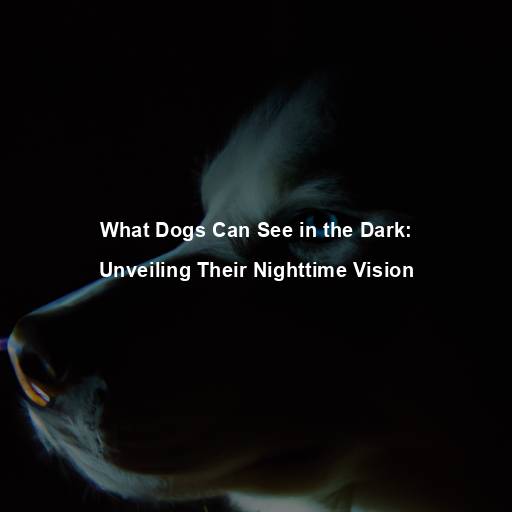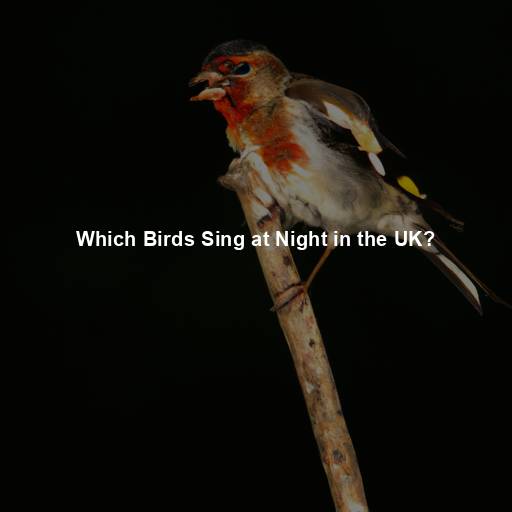What Dogs Can See in the Dark: Unveiling Their Nighttime Vision
Last Updated on November 12, 2023 by Evan
Contents [hide]
- 1 Understanding the Canine Eye
- 1.1 The Anatomy of Canine Eyes
- 1.2 Exploring the Nighttime Superpower: Tapetum Lucidum
- 1.3 A World of Shadows and Enhanced Motion Perception
- 1.4 The Perception of Ultraviolet Light
- 1.5 Understanding the Limitations
- 1.6 Unveiling the Mysteries of Canine Night Vision
- 1.7 Evolutionary Adaptations
- 1.8 Selective Breeding and Night Vision
- 1.9 The Role of Training and Sensory Development
- 1.10 A Comparative Look: Human vs. Canine Night Vision
- 1.11 The Fascinating World of Canine Vision Unveiled
- 2 FAQs
Understanding the Canine Eye
Throughout the ages, dogs have captivated us with their awe-inspiring senses. Among these remarkable abilities lies the enigma of their vision, particularly in the cloak of darkness. Curiosity lingers as we ponder what concealed vistas unfold before their keen eyes in the abyss of night. To decipher this canine nocturnal wonder, we must embark on a voyage into the depths of their ocular complexities, unearthing the secrets that grant them sight in the twilight realm.
The Anatomy of Canine Eyes
Similar to humans, dogs possess complex visual systems composed of various structures working in harmony. The key components of a dog’s eye include the cornea, iris, lens, retina, and tapetum lucidum. Each plays a crucial role in shaping their visual perception, especially in low-light conditions.
The cornea acts as a protective outer layer, responsible for focusing incoming light onto the iris, which controls the size of the pupil. Unlike humans, dogs have a larger pupil and a wider iris, allowing more light to enter their eyes in dark environments. This adaptation enhances their ability to gather limited available light.
As we delve into the intricacies of canine vision, a fascinating journey unveils before us. Within the depths of their eyes lies a complex system that guides them through the darkness, all starting with the mysterious iris. But the true marvel lies in the lens, an enigmatic entity that harnesses the incoming light and directs it with purpose onto the retina. It is within this very retina that the remarkable photoreceptors reside, waiting patiently to transform light into electrical signals, launching a mystical dance of communication with the brain via the optic nerve.
Exploring the Nighttime Superpower: Tapetum Lucidum
The tapetum lucidum is a reflective layer located in the back of a dog’s eye, just behind the retina. This unique feature sets dogs apart from humans when it comes to seeing in the dark. The tapetum lucidum acts as a natural mirror, reflecting and amplifying incoming light, thus maximizing the sensitivity of the photoreceptor cells.
As light gracefully journeys through the intricate pathways of a dog’s eye, a mystifying phenomenon occurs – the tapetum lucidum comes alive, playfully reflecting and redirecting any photons that have yet to find their purpose. This ethereal dance grants these noble creatures a remarkable prowess in the art of light detection, enabling them to effortlessly uncover the faintest glimmers that beckon them on their nocturnal quests. It is through this enigmatic mechanism that dogs are bestowed with an extraordinary gift, allowing them to navigate the darkness with both grace and curiosity.
A World of Shadows and Enhanced Motion Perception
While dogs may not see as clearly as humans in bright daylight, their visual system is specifically designed to excel in low-light conditions. Their eyes are more sensitive to motion and changes in contrast, which allows them to detect subtle movements in the dark. This heightened motion perception comes in handy during activities such as hunting or guarding, where the ability to spot prey or intruders in dimly lit environments is crucial.
Did you know that dogs actually have more rod cells in their retinas than humans? These specialized cells allow dogs to see better in low light conditions and perceive a wider range of shades of gray. So, while they may not see colors as vividly in the dark, they sure have a knack for detecting objects and navigating their environment with incredible precision. It’s just another fascinating aspect of our canine companions’ sensory abilities.
The Perception of Ultraviolet Light
Another fascinating aspect of a dog’s visual prowess is their ability to perceive ultraviolet (UV) light. While humans can only see a limited range of colors in the visible spectrum, dogs have an extra dimension to their vision. The lenses in their eyes allow UV light to pass through, revealing a hidden world of colors and patterns that remain invisible to us.
This heightened sensitivity to UV light might explain why dogs appear to have an uncanny knack for tracking scents and finding hidden objects. Certain substances, such as urine or saliva, leave behind UV traces that dogs can easily spot, aiding them in their tracking and detection abilities.
Understanding the Limitations
While dogs possess remarkable night vision capabilities, it’s important to acknowledge that their vision is not without limitations. Despite their ability to see in the dark, dogs still face challenges in complete darkness or when navigating unfamiliar terrain. Here are a few factors that can impact their nighttime vision:
-
Total darkness: In pitch-black environments, where there is an absence of any available light, dogs’ night vision becomes less effective. Their tapetum lucidum requires at least some ambient light to reflect and amplify.
-
Age and health: Older dogs or those with certain eye conditions may experience a decline in their night vision abilities. Regular veterinary check-ups and early detection of any eye-related issues are essential for maintaining a dog’s visual health.
-
Breed variations: Different dog breeds may have varying degrees of night vision capabilities. Some breeds, such as the Siberian Husky or the Alaskan Malamute, have evolved to thrive in low-light conditions, while others may have less pronounced abilities.
When it comes to dogs and low-light adventures, there are a couple of factors that can make a real difference. First off, training plays a crucial role as dogs who are skilled in navigating in the dark tend to perform better in such conditions. Moreover, familiarity with their surroundings actually gives them an extra edge as they can rely on their other senses, like smell and hearing, to enhance their visual capabilities.
Unveiling the Mysteries of Canine Night Vision
As the veil of darkness is gradually lifted, we venture into the realm of the enigmatic and unveil the cryptic wonders that lie within a dog’s vision. With an incomprehensible blend of ancient instincts and refined genetic craftsmanship, their eyes have metamorphosed into divine instruments, finely honed to decipher the ethereal tapestry of dimly lit realms. From the enigmatic gleam of the tapetum lucidum to their unearthly mastery of discerning motion and the captivating ability to perceive rays beyond the visible spectrum, these furry companions possess an unrivaled visual prowess that effortlessly guides them through the twilight of existence.
So, the next time you find yourself walking your furry friend under a starlit sky, take a moment to ponder the wonders of their nighttime vision. As they lead the way, sniffing out hidden scents and confidently maneuvering through shadows, you’ll witness firsthand the magic of what dogs can see in the dark. ## The Influence of Evolution and Breeding on Canine Night Vision
Exploring the enigmatic realm of a dog’s captivating vision in low-light conditions unveils an intriguing narrative of evolutionary twists and selective breeding serendipities. As dogs tread the path of domestication, their genetic composition endures a cryptic metamorphosis, yielding a captivating tapestry of nocturnal ocular prowess across breeds. In this kaleidoscope of canine night vision, every enigmatic strand reveals a mesmerizing tale, a testament to the manifold mysteries that interplay in the intricate world of our furry companions.
Evolutionary Adaptations
Throughout history, canines have honed their instincts to excel in diverse environments, adapting to the challenges of both the hunt and gathering. Over time, their evolutionary journey has bestowed upon them a remarkable ability to navigate the treacherous terrain of the night, where their predatory prowess truly shines. As if touched by a supernatural force, the canine’s night vision elevates them to a league of their own, giving them an edge in the clandestine realm where darkness reigns supreme.
Throughout evolution, the fascinating phenomenon of enhanced night vision has been quietly at work. Generations have witnessed the genetic inheritance of specialized visual structures and a remarkable ability to perceive even the faintest glimmers in the dark. As if driven by an ancient enchantment, dogs have emerged as masters of the night, skillfully navigating through diverse landscapes, their survival intricately intertwined with their heightened sensitivity to the realms of shadow and obscurity.
Selective Breeding and Night Vision
As humans began domesticating dogs, selective breeding played a significant role in shaping the visual abilities of different breeds. Breeders aimed to enhance certain characteristics, including night vision, to meet specific working or aesthetic standards.
For example, breeds like the German Shepherd and Belgian Malinois were selectively bred for their exceptional tracking and herding abilities, often requiring them to perform tasks in low-light conditions. As a result, these breeds tend to exhibit superior night vision compared to others.
On the other hand, breeds such as the Pug or the Bulldog, which were primarily bred as companion animals, may not possess the same level of night vision capabilities as their working counterparts. The focus of breeding for these breeds was primarily on physical appearance and temperament rather than visual acuity in dimly lit environments.
The Role of Training and Sensory Development
The fascinating world of canine night vision has sparked a captivating debate among experts, unveiling a tapestry of factors that contribute to their unparalleled visual prowess. As we delve deeper into this enigmatic realm, it becomes apparent that genetics and breeding imbue dogs with a foundation for their nocturnal acuity. However, it is the intricate interplay of training and sensory development that truly unravels the astuteness of their sight in the darkness. Whether they are mastering the art of navigating uncharted realms or accomplishing extraordinary feats under the dimmest of lights, dogs prove time and again that their night vision capabilities are a mesmerizing blend of nature and nurture.
One fascinating aspect of search and rescue dogs is their remarkable ability to locate missing individuals in different and often difficult environments, all with the added challenge of working in darkness. These incredible canines undergo rigorous training that hones their senses and teaches them to rely on their keen eyesight to pick up on nuanced clues and navigate through rugged landscapes, even when visibility is limited. It is truly awe-inspiring to witness these skilled dogs in action, skillfully using their vision to accomplish their life-saving missions.
Additionally, a dog’s sensory development during the critical stages of puppyhood can impact their visual acuity in low-light conditions. Adequate exposure to different light levels and environments during this period can help optimize their visual system’s development, enabling them to adapt more effectively to various lighting conditions as adults.
A Comparative Look: Human vs. Canine Night Vision
While dogs excel in their ability to see in the dark, it’s interesting to compare their night vision with that of humans. While some of the adaptations that enable dogs to see in low-light conditions are absent in humans, we still possess certain abilities that allow us to navigate in dimly lit environments.
Did you know that humans and dogs have quite a remarkable difference when it comes to their visual capabilities? While humans dominate in the realm of color vision and acuity in bright light, dogs hold the trump card in night vision. It all boils down to those fascinating cone cells in the retina, which humans possess in higher concentrations, enabling us to feast our eyes on the vibrant world of colors. On the flip side, dogs have the advantage of larger pupils, wider irises, and a shining hero named the tapetum lucidum, allowing them to navigate the darkness with astonishing ease.
In contrast, humans have a greater ability to perceive details and colors in well-lit environments. Our fovea, a small depression in the retina responsible for sharp central vision, grants us the advantage of intricate visual perception during daylight hours. However, in the absence of adequate lighting, our visual acuity diminishes significantly.
The Fascinating World of Canine Vision Unveiled
As our deep dive into the mystical realm of a dog’s nocturnal vision nears its end, we’re left spellbound by the enigmatic prowess these faithful companions possess. The intricate interplay between evolutionary forces and the tinkering of breeders has bestowed upon them an extraordinary array of ocular abilities that enable them to effortlessly conquer the dimmest of environs. Moments of wonder abound as we fathom the secrets behind their seamless navigation and flourishing existence in the cloak of darkness.
From their reflective tapetum lucidum to their heightened motion perception and the ability to perceive UV light, dogs possess an extraordinary visual system that unlocks a hidden realm of sensory experiences. As devoted pet owners, we can marvel at their night vision prowess and appreciate the wonders of the world as seen through their eyes.
So, the next time you venture out into the night with your canine companion, take a moment to appreciate their remarkable night vision capabilities. Embrace the shadows, trust their instincts, and embark on an adventure where the darkness reveals a tapestry of scents, sounds, and sights that only dogs can truly perceive.
FAQs
What dogs can see in the dark?
Have you ever wondered how dogs manage to see so effortlessly in the dark? It turns out that our furry friends have some incredible adaptations that help them navigate and perceive their surroundings, even in low light conditions. While it’s not fair to say that dogs can see in pitch-black darkness, they certainly have a knack for detecting objects, shapes, and movements when the lights are dim. Their ability to do so can be attributed to a combination of factors, such as their uniquely designed pupils, the magical tapetum lucidum, and specialized cells in their retinas. So next time you find yourself stumbling in the dark, just remember that your four-legged companion might be seeing things a lot clearer than you do!
What are the key adaptations that enable dogs to see in the dark?
One crucial adaptation that aids dogs in seeing in low light conditions is their larger pupils. Dogs can dilate their pupils significantly more than humans, allowing more light to enter their eyes. This allows them to capture more available light and improves their ability to see in dimly lit environments.
Dogs possess a fascinating adaptation known as the tapetum lucidum, a reflective layer tucked behind their retinas. Acting like a mystical mirror, this ingenious structure bounces light back through the retinas, granting the visual cells a double opportunity to grasp those elusive photons. Astoundingly, this intricate mechanism not only amplifies dogs’ ability to navigate in low light conditions but also lends a mystical glow to their eyes during the nocturnal hours.
Additionally, dogs possess specialized retinal cells called rods, which are highly sensitive to light and motion detection. These rods enable dogs to perceive movement better than humans in low light conditions. This ability is particularly useful for dogs during nighttime activities like hunting or guarding.
Do all dog breeds have the same night vision abilities?
Have you ever wondered why some dogs seem to navigate effortlessly through the darkness while others stumble around like lost souls? It turns out that the secret lies in their breed. While all dogs have an advantage over us mere humans when it comes to night vision, not all breeds are created equal in this department. Take German Shepherds, Border Collies, and Bloodhounds, for example. These remarkable canines have been selectively bred for specific tasks that require them to excel in low-light conditions. Their stellar night vision can be attributed to their impressive working backgrounds, which might involve heroic acts like search and rescue or masterful tracking skills. However, don’t despair if your furry friend belongs to a different breed; all dogs possess inherent adaptations that allow them to see better in the dark, regardless of their lineage. It’s simply a matter of degrees and specialized abilities. So next time you find yourself fumbling in the shadows, just remember that your dog might be the one leading the way with their extraordinary nocturnal vision.
Are there any limitations to dogs’ night vision?
When it comes to navigating the darkness, dogs are no strangers. Their nocturnal prowess is a marvel, captivating our imaginations. However, it’s important to remember that even in their mastery, dogs have their limitations. While they may see movement with razor-sharp precision, their discernment of intricate details and vibrant hues remains a puzzling enigma, trailing behind our human perception.
Did you know that even our furry friends, dogs, struggle with seeing in the dark? Yes, it’s true! In those pitch-black moments, their vision takes a hit, but fear not, for dogs have evolved to compensate with their exceptional sense of smell and hearing. These heightened senses serve as their trusty guides, allowing them to navigate their world with remarkable precision, even when visual clarity is at its lowest. It’s a fascinating reminder of the remarkable adaptations that animals possess to cope with the challenges they encounter in the dark!
When it comes to our furry friends, there’s a lot more to their sight than meets the eye. It turns out that age, specific medical conditions, and even previous injuries can throw a wrench in their night vision capabilities. So, if your canine companion is exhibiting any signs of visual trouble, it’s wise to seek the expertise of a trusted veterinarian to ensure their overall health and happiness.







